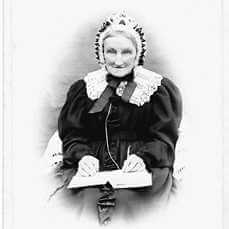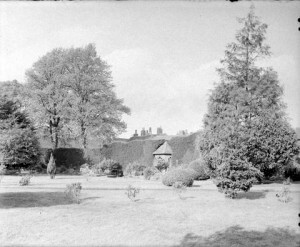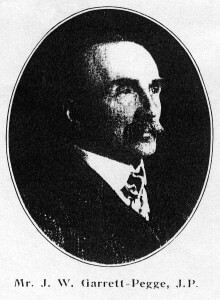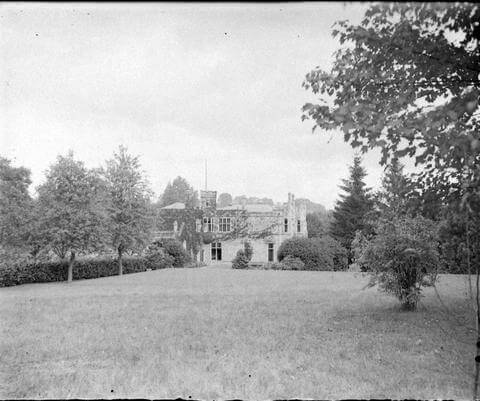(His name was later changed to John William Garrett-Pegge)
This article was written by Martin Thompson, whose paternal grandmother was a Garrett, with extra information provided by Alison Bailey. It now includes an article about one of John’s sons, Wilfred.
John, an only child, was born on 23rd July 1853 at Stepney Green in London, where his father, George Ward Pegg, was minister at Beulah Baptist Chapel in Commercial Road. George was descended from an armorial family that can be traced back to the beginning of the 16th century in Derbyshire. The family held lands and property throughout Derbyshire and surrounding counties.

John’s mother Mary was the eldest daughter and co-heiress of John Mary Garrett of Germain Street, Chesham (by Town Bridge.) Mary was the daughter of William Morten who died in 1832 leaving her “One tan yard and buildings 7 messes 7 barnes 7 stables 7 gardens and orchards 320 acres of land 40 acres of meadow and pasture 40 acres of wood common of pasture and other commonable rights with the appurts in the Parishes of Amersham Chesham Little Missenden Hitchendon otherwise Hughendon and Chesham Bois in the County of Bucks and the Tithes of the same lands and also 43 acres of woodland and 20 acres of land with the appurts in the Parish of Wiggenton in the County of Hertford” (source 1924 Abstract of the Title (Deeds) for Morten Chiltern Road). John Garrett ran the tannery and also owned much property in and around Chesham. His father, who had inherited property based at Hudnall (then in the parish of Edlesborough) which had been in the family since the 15th century or earlier, came to Chesham during the second half of the 18th century. The family had been leading members of the Baptist community since the middle of the 17th century.
John was only 8 years old when his father, George Ward Pegg, died and he then lived with his mother and grandfather at Germain Street. He was educated at Amersham Hall, Caversham, near Reading. This school, which had just relocated from 42 High Street, Amersham, was founded by a Baptist Minister for the sons of “dignified gentlemen.”
In recognition of his family’s Baptist credentials, John was invited to lay a cornerstone for the new chapel in Berkhampstead High Street on 11th October 1864. Later he travelled in the East with Rev James H Atkinson, a prominent Baptist minister.
Nearly 3 months before his 20th birthday John married Elizabeth Knowles Andrews at Chesham General Baptist Chapel in Star Yard, and the couple honeymooned on the Continent. Elizabeth was from a well established local Baptist family. They leased Blackwell Hall, Latimer for seven years and established themselves as pillars of the community in Chesham. Although of a retiring disposition and preferring the pursuits of a country gentleman rather than the prominence of publicity, from his early manhood he proved himself a useful citizen, and showed great ability in his work. In Jun 1894 his bull terrier won first prize in its class at Bicester Dog Show. Family life had its tragedies – their first child, a son, was stillborn on 15th September 1874 and the second, John Oswald Garrett Pegg (19th Jun 1877 – 9th April 1879), died in infancy. However the next two sons survived – Wilfred George (7th October 1880 – 1977) and Robert Owen (16 Aug 1882 – 20 Jul 1964.)
John was very involved with Chesham General Baptist Chapel, attending and chairing meetings, supporting bazaars, donating to Baptist charities etc. In 1882 he wrote to a local newspaper in defence of Dissenters and Treasurer of the Giles Hester Fund, providing an annuity for the former Baptist minister of Berkhampstead. In 1885 he took part in the stone laying ceremony of a new chapel at Chartridge. In 1889 John presided at a meeting of the Lower Baptist Chapel. He also supported the temperance movement by chairing meetings, proposing that a cocoa and coffee tavern be established at Chesham (this was later implemented) and, in 1883, being a founding committee member of the Chesham Auxiliary to the Central Association for Stopping the Sale of Intoxicating Liquors on Sunday. However it would appear that a rift took place because, in August 1893 John wrote to a local newspaper disclaiming a correspondent’s description of him as a Nonconformist and from 1894 he started supporting St Mary’s Church Schools Flower Show. His funeral service and burial took place at St Leonard’s, Chesham Bois.
Politics also interested John. In 1883 he was among the platform party at a public meeting of Chesham Liberal Association, and in following years chaired Liberal public meetings in support of Baron Ferdinand J de Rothschild M. P. At the parliamentary elections of 1886 and later years he was one of Rothschild’s proposers. In January 1889 he was elected to represent the Parish of Chesham as an independent councilor on very first County Council for Buckinghamshire and the first time that women had the vote. He came second of the 4 candidates competing for 2 seats, polling 471 votes out of 1,912 cast from 1,270 electors. At about the same time as he parted company with the Baptist church he joined the Junior Constitutional Club, and so had to pledge support to the Conservative Party, and in 1894 he was invited to be a Vice-President of Chesham Conservative Association. However in 1898 he was on the General Committee of the Unionists of Mid Bucks arranging a complimentary dinner to Baron Ferdinand Rothschild, and in the following year assented to the nomination of the Liberal & Liberal Unionist Lionel Walter, 2nd Lord Rothschild as election candidate. In 1909 he was a member of the platform party at a public meeting of the Chesham branch of the Tariff Reform League. In 1910 John was a proposer for the nomination of Lionel Nathan de Rothschild as the Conservative and Unionist candidate for Mid Bucks constituency, and in 1912, and following years, was re-elected a Vice President of the Chesham branch of Mid Bucks Conservative and Unionist Association. In 1913 he was elected as a Vice-President of the newly-formed Amersham and district branch of the National League for Opposing Women’s Suffrage. The Chesham branch was chaired by his friend Arthur Lazenby Liberty.
John had a deed chest that contained old deeds and papers relating to his maternal Garrett ancestors. Among these was an original Order, issued in pursuance of a proclamation made by Queen Elizabeth I, to William Garrett (John’s ancestor) and 4 other gentlemen of Edlesborough and Ivinghoe parishes. The Order was to identify Catholic sympathizers who might threaten the security of the realm. In 1900 John wrote about this in an article entitled “A Paper from a Family Deed-Chest” that was published in Records of Buckinghamshire by Buckinghamshire Archaeological Society. In 1904 he published a transcript of the first volume, 1538-1636, of Chesham parish register. This was followed by his article “Richard Bowles’ Book,” published in Records of Buckinghamshire by Buckinghamshire Archaeological Society in 1909 and 1910, detailing the restoration of St Mary’s church, Chesham in 1606. In 1905 he donated photographs of Stewkley, Stone and Aylesbury churches and of Quarrendon Ruins to Buckinghamshire Museum in connection with the jubilee of Buckinghamshire Archaeological Society. He continued to support the museum with a donation of 10 guineas in 1907. John was also a member of Buckinghamshire Parish Register Society.
John was a member of the Managing Committee of Chesham Cottage Hospital for over 41 years, including Honorary Secretary 1889 – 1908 and President from 1908 until 1915. In June 1906 he loaned the grounds of Chesham House for a bazaar and garden fete. During his term as President in 1911 he made a gift of an operating table. In September 1916 he also stood in as Honorary Secretary on behalf of his successor, his son Wilfred, who was ‘on service.’ (Cestreham House, a rehabilitation and nursing support centre on the site of the former hospital, includes the Garrett Pegge Unit for 15 – 19 year-olds.)
John was associated with many local organisations and events. During the years from 1878 he was nominated as Overseer for Botley, Waterside and Latimer; chairman of Chesham School Board (1878-1884); member of the Board of Guardians (1878-1893); gave financial aid to Lee Common British School; contributed to the cost of a new school at Chesham Bois in 1893; opened a bazaar in aid of Congregational Chapel; was a speaker at a public meeting following an assassination attempt on the Queen the previous day; presented prizes at annual Sunday School Union Festival; attended a public meeting to propose that Chesham be constituted a Local Government district; attended an entertainment by Chesham Boys’ British School; made an honorary member of Waterside Working Men’s Club; presented prizes at the Foresters and Oddfellows annual holiday; loaned plants and flowers for the Chesham Sunday School Union annual festivals; seconded motion of condolence to Queen on death of son Prince Leopold; patron of Chesham Cricket Club Athletic Sports; attended a public meeting about the Queen’s Jubilee; contributed 10s towards Townsend Road Board Schools Jubilee Tea and Sports; subscribed £3 : 3s to ‘Jubilee Gift to the poor of Chesham Parish’; attended annual Cottagers’ Vegetable & Flower Show at Lord Chesham’s park; a patron of annual Volunteer Fire Brigade Concert; chaired a Vestry Meeting of Chesham Bois ratepayers (1891); one of the invited guests to the official luncheon at the opening of the Metropolitan Railway extension to Aylesbury; a Patron of Chesham Friendly Society; chaired Chesham Bois Parish Meeting; donated £10 : 10s to Bucks County Museum; member of Old Age Pensions Sub-Committee of Amersham Rural District Council (1908); a patron of a dramatic and poetic recital at Chesham Town Hall; donated £5 : 5s to the Royal Buckinghamshire Hospital building fund; contributed £2 : 2s to the Buckinghamshire Memorial to Rt. Hon. Benjamin Disraeli, Earl of Beaconsfield, K.G.; a Vice President of Chesham Mechanics Institute, Chesham Football Club; Chesham Cricket Club, Chesham Choral Society, Chiltern Hills and Southern Bucks Agricultural Association, Chesham Allotment Holders’ and Cottage Gardeners’ Protection Society. In July 1907 he was elected the first President of the newly-formed public Chesham Rifle Club, and provided the Club with a miniature range in an old chalk pit at Aldridge Dell, Chesham Bois. This was opened by Lord Chesham on 3rd August 1907. John was still President in 1916.
Within a few weeks of the outbreak of war the rifle range at Aldridge Dell, Chesham Bois was offered for use for shooting practice. John made contributions to the Buckinghamshire Territorial Units’ Comforts Fund and a fund to increase the capacity of the Royal Bucks Hospital. During Apr-May 1918 he supported the YMCA “Buckinghamshire Hut Weeks” which include flag days and entertainments to raise funds for huts, tents, equipment and maintenance on the Western Battle Fronts.
It was upon the Commission of the Peace that John did some of his most valuable work, where he was said to be impartial and always just. He was sworn in as a Justice of the Peace on 9th August 1889 and got to work immediately, attending Great Missenden Petty Sessions on 12th August, Chesham Petty Sessions on 14th August and Amersham Petty Sessions on 29th October. He continued to give a great deal of his time to the Petty Sessions for many years. At Chesham he attended sessions 2 or 3 times a month, Amersham once or twice a month and periodically he would cycle to Great Missenden to attend sessions there. He was appointed Chairman of the Bench at Chesham in 1900 and at Amersham in 1903. On 6th February 1901 he gave a speech at the Petty Sessions in tribute to the late Queen. His wide knowledge of what may be termed magisterial law, made him of immense service as Chairman, and enabled him to give decisions in many difficult cases the legal soundness of which was undeniable – in fact upon appeal his judgments stood the test and were not reversed. He regularly attended the county Quarter Sessions and several times served on the Grand Jury. The magistrates at Bucks Quarter Sessions appointed him to several magisterial offices. These included an appointment to make reception orders to receive lunatics under the Lunacy Amendment Act (a role he held from 1889 until at least 1918,) in 1905 membership the new County Licensing Committee (Chairman 1916-1918,) in 1908 membership of the County Smallholdings & Allotments Committee (resigned after 8 months), membership of a sub-committee of the Bucks discharged Prisoners’ Aid Society with a duty to meet at St Albans Prison and make provision for assisting prisoners due for discharge (resigned in 1919,) and in 1916 assessor under the Clergy Discipline Act. In 1917 John attended the funeral of Sir Arthur Liberty, fellow magistrate and founder and Chairman of Liberty & Co Ltd., the Regent Street department store.
John’s grandfather, John Garrett, died in 1868 leaving his property to his 2 daughters and their children. The property that John W G Pegg inherited as a young man was added to in 1908 when his mother died. In 1896 he said he had an interest in 1,000 acres of land in the parish of Chesham and considerable house property in the town. The land included Bois Farm, Captain’s Wood, Amy Mill Pond (presumably the mill as well,) Great Bois Wood, Hodd’s Wood, and Cherry Tree Wood at Asheridge.
In 1906 a substantial part of Bois Farm was sold by John, his mother Mary Pegg, and Fred Butcher (Mary’s sister’s husband) as valuable building plots. This led to the development of Clifton Road, Chiltern Road and Chesham Road and substantially increased the size of Chesham Bois village.
At Bellingdon he was regularly troubled by poachers, even though he employed a gamekeeper. The regular sale of felled trees and the letting of farmland provided a good income. Other property in Chesham included a workshop and timber yard, and also the river bed at Town Bridge, for which he received a nominal rent of a shilling per annum from the Urban District Council for the right to deposit snow from road clearing. In January 1889 he had a mortgage on 61 and 79 High Street (formerly Deely’s), Chesham, along with John Garrett Morten and Frederick Butcher.

During 1879 John had new house under construction at New Road, Chesham Bois. This was a neo-gothic 20-room mansion designed by J Wallis Chapman and was to be called Chesham House. New Road was built about 1827 and later renamed Amersham Road, A416.

The family moved to Chesham House from Blackwell Hall by October the following year. The household consisted of John, Elizabeth, baby Wilfred, Elizabeth’s brother, a nurse, cook, parlourmaid and housemaid. In February 1888 John obtained authority from the Local Board to lay a water main, at his expense, to Chesham House. He had to pay about 1s :4d per 1000 gallons for the water. At some time between 20 Jul 1907 and 18 Jan 1908 he changed the name of the house to Chesham Bois Manor.
During the period 1894 – 1902 John led some of Lord Chesham’s copyhold tenants, aided by the Commons Preservation Society, to assert their rights of pasture and oppose any unnecessary breaking up of Chesham Moor. Chesham Urban District Council wanted to turn the Moor into a recreation ground, though the Commoners claimed that this was illegal.
 On 11 Aug 1899 John changed his name by deed poll from John William Garrett Pegg to John William Garrett-Pegge. He announced this on the front page of The Times newspaper and in the Bucks Herald.
On 11 Aug 1899 John changed his name by deed poll from John William Garrett Pegg to John William Garrett-Pegge. He announced this on the front page of The Times newspaper and in the Bucks Herald.
In Oct 1903 John purchased from the Duke of Bedford “all that the manor or Lordship of Chesham Bois or so much thereof that is situate within the Parish of Chesham Bois in the Counties of Buckingham and Hertford with the rights members and appurtenances thereof”. This included Chesham Bois Common and Chesham House. As lord of the manor he received a rent of 3d per annum payable by Lord Chesham for a fence at Chesham Bois, and suggested to Amersham Rural District Council that a metalled road should be built across Chesham Bois Common to prevent further damage by vehicular traffic. In September 1919 he purchased 2 acres land near Chesham Bois Mission Hall, costing about £500-600, and gifted it to Amersham Rural District Council Housing Committee for the building of cottages.
By 1918 increasing ill health caused John to become less active in public life, and he died of heart failure, accelerated by influenza at Chesham Bois Manor on Friday 16th April 1920. A quiet and simple funeral and burial took place at St Leonard’s, Chesham Bois on Tuesday 20 April 1920, with the coffin borne by estate employees. In attendance were Mr William F Lowndes (squire) and Mr H Jacobs (representing Lady Liberty), along with magistrates and representatives of many other bodies. In tributes John was said to be a man of great intellect and strong personality, and was always keenly animated by a strong sense of duty, as well as being courteous and tactful. John was survived by his wife Elizabeth, who died 4 years later, and their 2 sons Wilfred and Robert.
Wilfred George Garrett-Pegge (1880-1987)
Wilfred was born 7th October 1880, the first surviving child of John William Garrett Pegg and Elizabeth Knowles Andrews. Less than 2 years later Wilfred’s brother Robert was born. The family surname became Garrett-Pegge in 1899 when John changed his name by deed poll, just 3 years before purchasing the manor of Chesham Bois.
Wilfred was brought up at Chesham House, a neo-gothic 20-room mansion built for the family in 1879-80, and played hockey in his youth. He gained a BA and MA at Merton College, Oxford and was called to the Bar at the Inner Temple in 1904.
 In 1916 Wilfred graduated from an Officer Training Course and joined the Royal Army Service Corps. He served in France and Belgium, rising through the ranks to Lieutenant. His brother Robert also rose to Lieutenant in the RASC and was mentioned in despatches. During the Second World War the County Emergency Committee appointed him as Sub-Controller for Area No. 5, which comprised of Chesham, Amersham and Beaconsfield. In 1940 he loaned Chesham Bois Manor (Chesham House had been re-named in 1907) for a children’s fun fair in aid of Lady Chesham’s Free Wool & Comforts Fund.
In 1916 Wilfred graduated from an Officer Training Course and joined the Royal Army Service Corps. He served in France and Belgium, rising through the ranks to Lieutenant. His brother Robert also rose to Lieutenant in the RASC and was mentioned in despatches. During the Second World War the County Emergency Committee appointed him as Sub-Controller for Area No. 5, which comprised of Chesham, Amersham and Beaconsfield. In 1940 he loaned Chesham Bois Manor (Chesham House had been re-named in 1907) for a children’s fun fair in aid of Lady Chesham’s Free Wool & Comforts Fund.
In 1907 Wilfred was elected the first Honorary Secretary of the newly-formed Chesham Rifle Club (his father was President.) He worked to prepare the range in an old chalk pit at Aldridge Dell, Chesham Bois in time for the opening by Lord Chesham on 3rd August 1907. Wilfred succeeded his father as Honorary Secretary of Chesham Cottage Hospital in 1915. In the 1920s he was a Vice-President of Chesham Conservative & Unionist Association.
Following in his father’s footsteps, Wilfred was appointed by the Lord Chancellor to the Commission of the Peace for Buckinghamshire in 1909 and sworn in as a Magistrate during the Easter Quarter Sessions that year. By 1930 he was Vice Chairman of Amersham Bench by 1930 and Chairman in 1935.
Wilfred succeeded his father as Lord of the Manor of Chesham Bois in 1920, and continued to reside at Chesham Bois Manor. In 1936 he gave up a piece of land to allow improvement work at the junction of Copperkins Lane, and in 1953 let the common land of the Manor at a peppercorn rent to Chesham Bois Parish Council, retaining the rural condition. In the 1970’s the ownership of Chesham Bois Common was in dispute as Buckinghamshire County Council had no record of the Garrett-Pegges owning the land. This was resolved in 1973 when Wilfred and Francis How Solicitors attended a hearing before the Commons Commissioner to prove that Chesham Bois Common had been purchased from the Duke of Bedford in 1903 by Wilfred’s father “All that the Manor or Lordship of Chesham Bois or so much thereof as is situate within the Parish of Chesham Bois in the Counties of Buckingham and Hertford with the rights members and appurtenances thereof”. As John William Garrett-Pegge had bequeathed the land to his two sons on his death in 1920 the Commissioner accordingly directed “Buckingham County Council as registration authority to register Mr Wilfred George Garrett-Pegge as the owner of the land under section 8(2) of the Act of 1965”.
Wilfred died a bachelor on 23rd December 1977 and his ashes were interred in the family vault at St Leonard’s, Chesham Bois. The executors of his will were his niece Constance Joan Garett-Pegge, his nephew John Robert Garrett-Pegge and John Robert’s son James Owen Garrett-Pegge all of the Meades, Germain Street Chesham. Apart from some personal legacies including one thousand pounds each to two servants for “faithful and ungrudging service to my family for more than forty years” the estate was left to his surviving family.
In 1978 Chesham Bois Manor in 8 acres of land was sold to B&M Investments Ltd who converted it into a care home. B&M Care still run it as a care home today. Chesham Bois Common was sold to the Parish Council in 1979.
The title of Lord of the Manor of Chesham Bois was not mentioned in Wilfred’s will. The family believed the title to have been conveyed to the Council with the Common but this does not appear to have been the case. In a letter dated 29 September 1998, The Manorial Society of Great Britain advised that their records show Wilfred as the Last Lord of the Manor and as the family did not continue to use the title it appears to have fallen into abeyance with his death in 1977.

